Understanding Your Journey: Navigating Through Trauma Together
As your counselor, I want to embark on this journey with you, not just as a guide but as a partner who truly understands the depth of what you’re experiencing. Trauma is not a journey anyone should navigate alone, and my role is to walk beside you, illuminating the path forward as we explore this terrain together. This letter aims to bridge the gap between the experiences that have shaped you and the hope that lies ahead as we understand and navigate your trauma together.
The Nature of Trauma
Trauma can manifest from experiences that are deeply distressing or disturbing to you. It’s important to acknowledge that what constitutes trauma varies significantly among individuals; what deeply affects one person might not impact another in the same way. This variation does not diminish the validity of your feelings or experiences. Trauma can stem from a single event, a series of events, or even a chronic state of stress. It might be a personal experience of violence, the sudden loss of a loved one, witnessing harm to others, or any event that has profoundly shaken your sense of safety and well-being.
How Trauma Affects You
Trauma can profoundly impact physical and emotional health. It’s common to experience a wide range of feelings, including sadness, anger, denial, fear, and shame. These emotions are normal reactions to abnormal events. On a physical level, you might notice changes in your sleeping patterns, appetite, or energy levels. Emotionally, you may feel more anxious than usual, experiencing mood swings, or having difficulty trusting others.
The Body and Mind Connection
Your body and mind are closely connected in how they respond to trauma. The term “fight, flight, or freeze” might be familiar to you; it describes the body’s natural reaction to danger. When facing traumatic events, your body may remain alert, affecting your ability to cope with daily activities and stressors.
The Impact on Relationships
Trauma can also affect how you interact with others. You might withdraw from friends and family or struggle to communicate your feelings and needs. It’s essential to recognize these changes as part of your trauma response, not as flaws in your character.
The Path to Healing
Healing from trauma is a deeply personal and often nonlinear journey. It involves recognizing the impact of your experiences and learning how to cope with the emotions and memories that arise. As we work together, we will explore various strategies to support your healing process, including:
Creating a Safe Space
Our first step is establishing a safe and supportive environment where you can express your thoughts, feelings, and experiences without judgment. This safe space is crucial for your healing journey, allowing you to explore your emotions and memories at your own pace.
Developing Coping Strategies
Together, we will develop coping strategies that suit your individual needs. These might include mindfulness techniques, breathing exercises, or grounding practices that can help you manage anxiety and other distressing emotions.
Building Resilience
Resilience is the ability to bounce back from difficult experiences. Part of our work together will involve strengthening your resilience through positive relationships, fostering a sense of purpose, and enhancing your ability to adapt to change and adversity.
Processing and Integrating Traumatic Memories
Processing traumatic memories can be challenging, but it’s a crucial step towards healing. We will gently explore these memories, helping you to integrate them into your life story in a way that reduces their power to cause pain.
Reconnecting with Others
As you progress through your healing journey, we will also focus on rebuilding and strengthening your relationships. Connecting with others can provide significant support and reinforce the sense of belonging and community essential for healing.
Your Journey is Unique
It’s important to remember that your journey through trauma is unique to you. Healing doesn’t mean forgetting or eliminating pain; it means developing a new understanding and relationship with your experiences. As we navigate this path together, my commitment to you is unwavering support, knowledge, and hope. Your strength, resilience, and courage are the beacons that will guide us through the darkness towards a place of healing and peace.
Embracing Your Story
One of the most potent aspects of your healing journey is embracing your own story. Your experiences, no matter how painful, are a significant part of who you are. Together, we’ll work on understanding your narrative, not intending to rewrite it but adding new chapters reflecting your resilience and growth. This involves recognizing your strengths, acknowledging your progress, and understanding that while trauma is a part of your story, it does not define you. Your courage in facing your past and commitment to healing speak volumes about your character and capacity to overcome.
The Role of Self-Compassion
Self-compassion is a critical component of your healing journey. It’s about treating yourself with the same kindness, care, and understanding you would offer a good friend. Trauma can often lead to harsh self-criticism and a skewed perception of self-worth. Together, we will cultivate a practice of self-compassion, which involves forgiving yourself, recognizing your human limitations, and understanding that you are not to blame for your trauma. By nurturing self-compassion, we can soften the impact of trauma and create a supportive inner dialogue that encourages healing and growth.
Finding Meaning After Trauma
Finding meaning in the aftermath of trauma is a deeply personal and transformative process. It’s not about finding a “silver lining” but discovering personal significance and growth amidst adversity. This might involve exploring new interests, engaging in activities that bring you joy, connecting with others who have had similar experiences, or even using your journey to help others. The search for meaning is an ongoing process that can lead to profound insights and a renewed sense of purpose in life.
The Importance of Patience
Healing from trauma takes time, and it’s important to move at your own pace. There will be days when you feel like you’ve taken a step back, and that’s okay. Healing is not linear, and setbacks are a natural part of the process. Patience with yourself and the journey is crucial. Remember, every small step forward is a victory. Celebrate your progress, no matter how insignificant it may seem. The path to healing is built on patience, perseverance, and the understanding that healing is a journey, not a destination.
The Power of Hope
Finally, I want to talk about the power of hope. Hope is a guiding light on your journey through trauma. It’s the belief that things can get better, that healing is possible, and that you have the strength to face the challenges that come your way. Hope keeps us moving forward, even when the path is difficult. As your counselor, I am here to hold onto hope for you when you might find it hard to do so yourself. Together, we will find ways to nurture this hope and envision a future where you are surviving and thriving.
In closing, I want you to know that your feelings are valid, your experiences are essential, and your journey toward healing is worthy of respect and admiration. As we continue to work together, remember that you are not alone. I am here to support you, to listen to you, and to walk with you every step of the way. Your resilience is robust, and together, we can navigate the challenges of trauma, finding peace, understanding, and healing on the other side.
Thank you for trusting me with your story and your journey. I am honored to be a part of your path to healing.
The post Understanding Your Journey: Navigating Through Trauma Together appeared first on Kevon Owen, Christian Counseling Clinical Psychotherapist.



